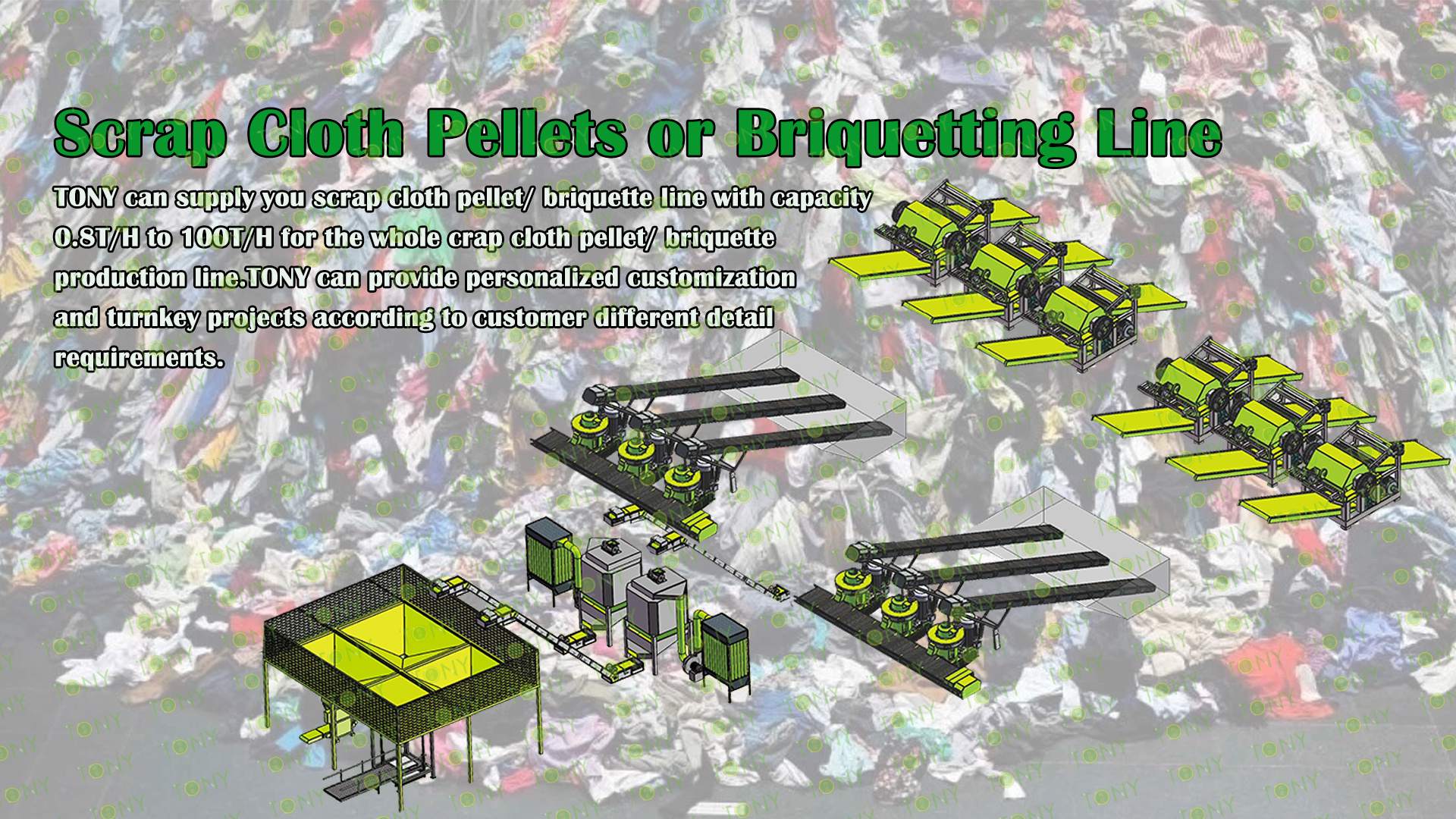
TONY Design Scrap Cloth Pellet/Briquette Line Specification
The burning of scrap cloth will cause many disadvantages, mainly including the following aspects:
1. Environmental Pollution:
Scrap cloth is mainly made of chemical fiber, cotton, linen, polyester and other materials, among which chemical fiber and polyester are not easy to degrade in natural state. When these materials are incinerated, a large number of toxic and harmful gases are released, including carbon oxides and sulfur oxides. These gases not only pollute the atmosphere, but also form acid rain, further damaging ecosystems.
2. Health Hazards:
The toxic and harmful gases released by burning scrap cloth pose a threat to human health. For example, dioxin is a colorless and odorless persistent pollutant, which is generated in the incineration process and has serious toxicity, which may lead to skin diseases, immune function impairment, endocrine and metabolic disorders, teratogenic cancer and other health problems. The World Health Organization classified it as a Class 1 carcinogen in 1997.
3. Soil Pollution:
The ashes of Scrap cloth after incineration contain a lot of harmful substances, which will be deposited in the soil and cause irreversible soil pollution. In extreme cases, contaminated land may not be able to grow any plants for decades or even centuries.
4. Waste Of Resources:
Scrap cloth is a recyclable resource. Recycling 1kg of used clothing can reduce CO2 emissions by 3.6kg. However, when scrap coth is burned, this potential resource value is completely wasted.
To sum up, the improper disposal of scrap cloth, especially incineration, has caused significant negative effects on the environment and human health. Therefore, it is particularly important to promote the recycling and reuse of scrap cloth.
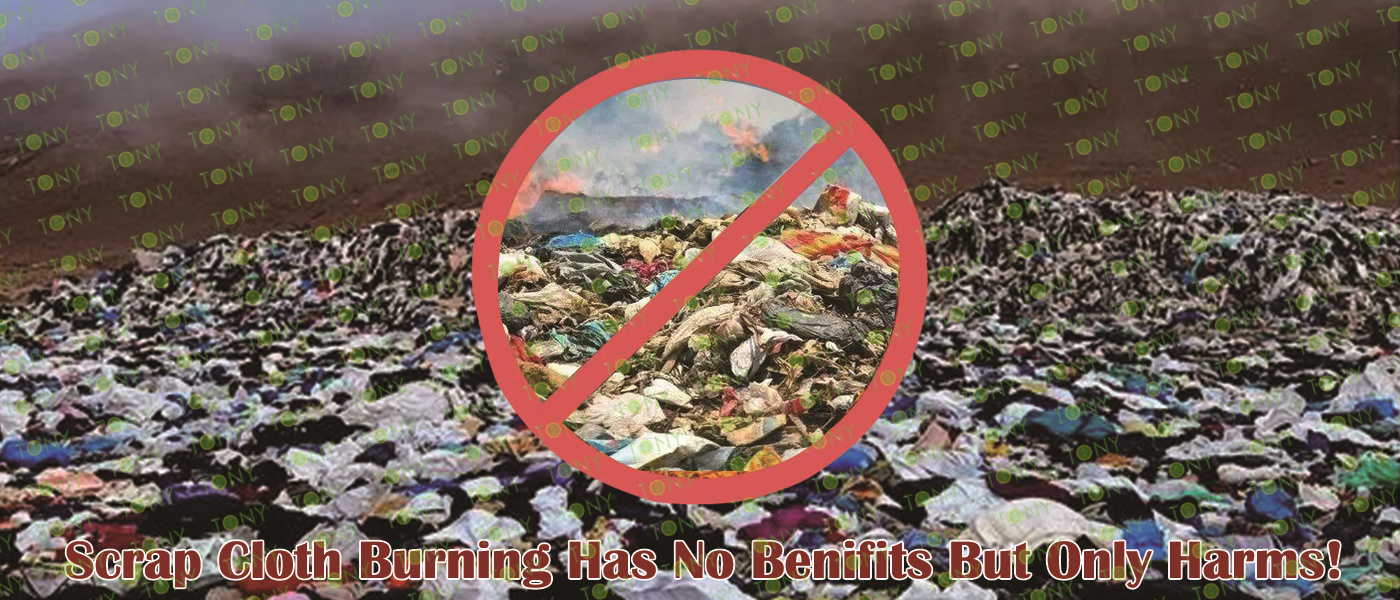
Scrap cloth can be recycled in a variety of ways, ranging from simple reuse to complex chemical treatment. Here are some of the main recycling methods:
1. Donate
Donate To Charity: Donate scrap cloth to charitable organizations or second-hand clothing stores that sell or distribute the cloth to those in need. Donations can not only reduce the burden of waste clothing on the environment, but also provide affordable clothing options for those in need.
2. Recycle
(1) Physical Recycling: through the shredder will be broken into small pieces of waste clothing, and then after washing, disinfection and other treatment, used to produce new fibers or products. Physical recycling is applicable to the recovery of single-component natural fibers or synthetic fibers, such as waste wool fibers and polyester fibers.
(2) Chemical Recycling: Use chemical methods to treat waste textiles, depolymerize and decompose the polymer, repolymerize and draw silk, obtain monomer, and then manufacture new fibers. Chemical recycling does not apply to natural fibers, but it can be applied to synthetic fibers.
(3) Energy Recovery: The chemical fibers with high calorific value in scrap cloth are converted into heat through incineration for thermal power generation. This method is suitable for used textiles that cannot be recycled.
3. Remanufacture
(1) Creative Design: transform scrap cloth into new fashion products, such as redesigned clothing, household items and accessories, through designing, cutting, sewing and other processing. This approach not only extends the service life of clothing, but also creates unique and personalized products.
(2) Household Items: scrap cloth is made into carpets, floor MATS, throw pillows, cushions and other household items to add a warm atmosphere to the family.
(3) Children's Toys And Supplies: cut and fill waste cloth to make soft toys, baby blankets, bibs and other supplies to create a pleasant play and living environment for children.
(4) Handicrafts: Through cutting, collage, sewing and other manual skills, the waste fabric will be made into patchwork pillows, patchwork hanging ornaments, hand-embroidery and other unique handicrafts.
4. Biomass Pellet Fuel
Transform Scrap Cloth Into Biomass Pellet Fuel: After crushing, removing iron and fine crushing, the scrap cloth is heated and compressed into biomass pellet fuel by biomass pellet machine. These biomass pellet fuels can be used in power plants, cement plants or other energy facilities to replace traditional fossil fuels, reduce dependence on finite fossil fuels, and reduce greenhouse gas emissions.
Through these methods, waste clothing can not only be effectively disposed of, but also contribute to environmental protection and resource recycling.
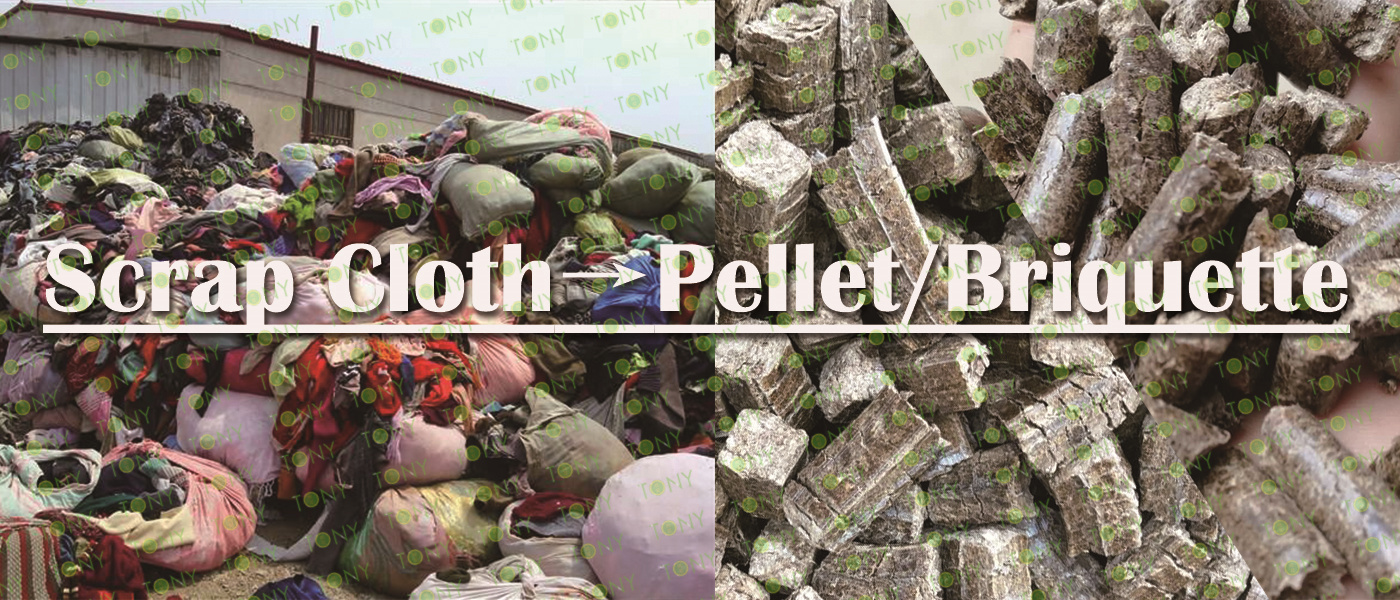

1. Reduce Environmental Pollution
(1) Landfill And Incineration Problems:If scrap cloth is directly landfill or incineration, it will occupy a large amount of land resources, produce harmful gases and pollutants, and cause serious pollution to the environment.
(2) Replace Traditional Fuels: Processing scrap cloth into biomass pellets or compacts can replace traditional fuels such as coal, reduce the use of fossil fuels, and thus reduce the emission of greenhouse gas and other pollutants.
2. Economic Value
(1) Resource Reuse: Scrap cloth itself is waste, which can be transformed into valuable resources and achieve economic value-added by processing into biomass particles or pressed blocks.
(2) Cost Saving: After processing into biomass pellets or pressed blocks, the cost of treating scrap cloth can be reduced, while the cost of landfill and incineration can be reduced.
3. Energy Efficiency
(1) High Combustion Efficiency: Biomass particles and compactors have high combustion efficiency and stable combustion performance, which can meet the production needs of different enterprises.
(2) Multi-Functional Applications: These particles or compacts can be used in power plants, cement plants, steel mills and other industrial scenarios to replace traditional fuels and improve energy efficiency.
4. Social And Environmental Benefits
(1) Job Creation: The processing and reuse process of scrap cloth can create new jobs and promote economic development.
(2) Community Participation: The environmental awareness of residents can be improved and the sustainable development of the community can be promoted through the scrap cloth treatment project in the community.
(3) Reduce Resource Waste: The recycling of scrap cloth can reduce the demand for new raw materials, save resources and reduce the environmental cost of producing new clothes.
5. Policy Support
In Line With National Policies: Processing scrap cloth into biomass pellet or briquette is in line with the national policy requirements of energy conservation and emission reduction, which is conducive to protecting the environment and reducing greenhouse gas emissions
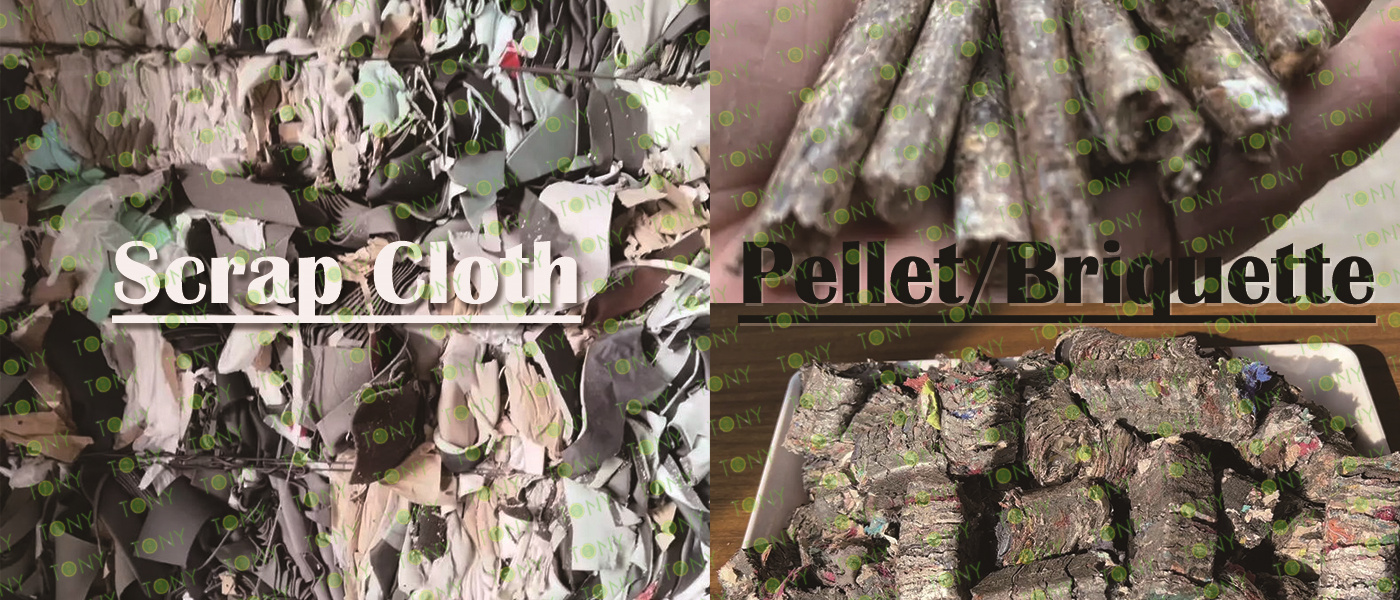

1. Economic Benefits
Scrap cloth pellet/briquette is a product that converts scrap cloth into a highly efficient fuel through dense curing molding technology. This fuel has the characteristics of large capacity, small size, high thermal efficiency, cleanliness and hygiene, and can achieve "zero emissions" during the combustion process, that is, no slag discharge, smokeless, and very few harmful gases such as sulfur dioxide in the residual gas, so as not to pollute the environment. The calorific value of scrap cloth pellet/briquette fuel can reach 3700-- 5000Kcal/kg, with strong fire power and long combustion time. In special stoves, the combustion thermal efficiency can reach more than 70%. In addition, the use process is similar to coal, easy to ignite, easy to use; Compared with loose burning, the labor intensity is less and the biomass resources are saved. Due to these advantages,scrap cloth pellet/briquette can replace fuelwood, coal and liquefied gas as energy for production and living.
2. Social Benefits
The use of scrap cloth pellet/briquette can not only improve the rural living environment and people's living standards, but also supply clean energy for the countryside. This kind of fuel has huge raw material resources, universal accessibility, renewable, simple processing, and can be commercialized production and sales of renewable energy. The use of scrap cloth pellet/briquette is conducive to the construction of civilized ecological village.
3. Environmental Benefits
The use of Scrap cloth pellet/briquette can reduce the dependence on natural resources and play an important role in promoting the development of circular economy. Because it can achieve "zero emissions" during combustion, it can reduce air pollution and protect the environment.
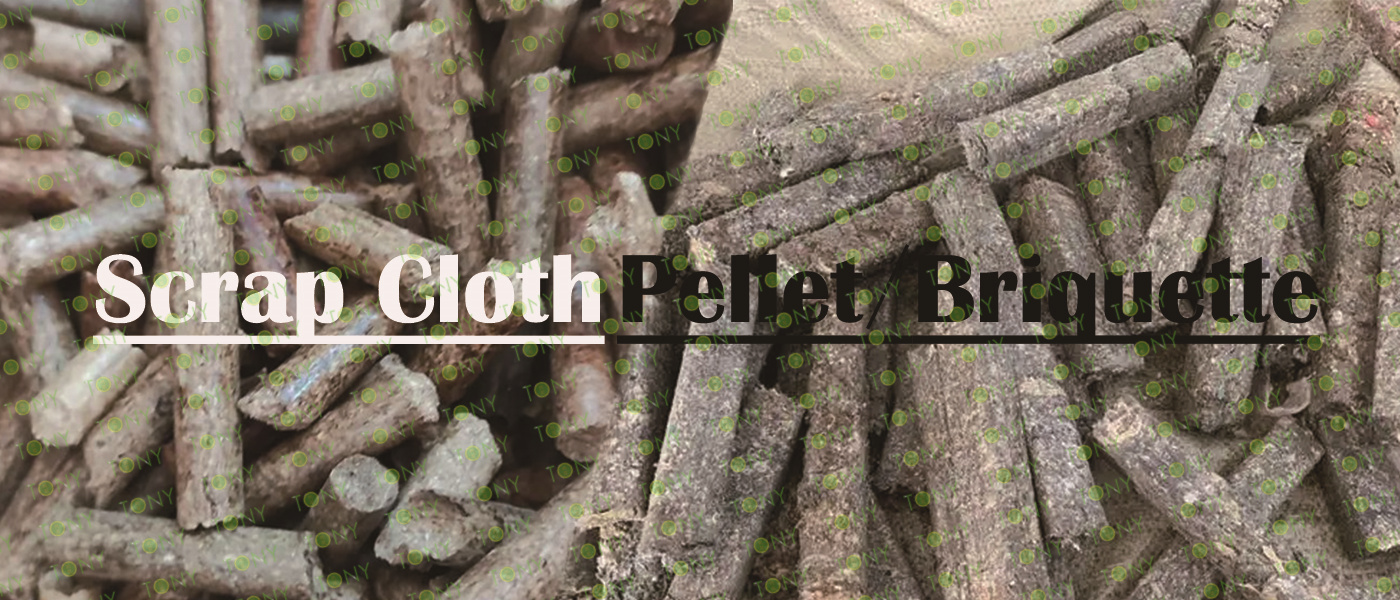

1. Environmentally Friendly
(1) Reduce Landfill: Scrap cloth transformed into scrap cloth pellet/briquette can effectively reduce the amount of landfill and reduce the occupation of land resources.
(2) Reduce Harmful Gas Emission: Compared with the traditional incineration method for scrap cloth, scrap cloth pellet/briquette generates less harmful gas in the combustion process, which is conducive to improving air quality.
2. Economic Fenefits
(1) Saving Resources: Scrap cloth is used to prepare scrap cloth pellet/briquette, which can reduce the dependence on the original resources and reduce the production cost.
(2) Job Creation: The collection, handling and processing of scrap cloth can create new jobs and promote economic development.
3. Energy Efficiency
(1) High-Efficiency Combustion: Scrap cloth pellet/briquette has high density and low water content, high combustion efficiency and can provide stable heat energy.
(2) Widely Applicable: Scrap cloth pellet/briquette can be applied to a variety of heating equipment, such as biomass burning furnace, suitable for home heating, industrial heating and other scenarios.
4. Technical Advantages
(1) Easy Storage And Transportation: Scrap cloth pellet/briquette is small in size, light in weight, easy to store and transport, and suitable for large-scale production and application.
(2) High Degree Of Automation: Modern production equipment can realize the automation of scrap cloth pellet/briquette production and improve production efficiency and product quality.
To sum up, scrap cloth pellet/briquette not only has significant advantages in environmental protection, but also can bring positive effects in economic benefits and technical application. By promoting the recycling technology of waste clothes, the recycling of resources can be realized and the realization of sustainable development goals can be promoted.
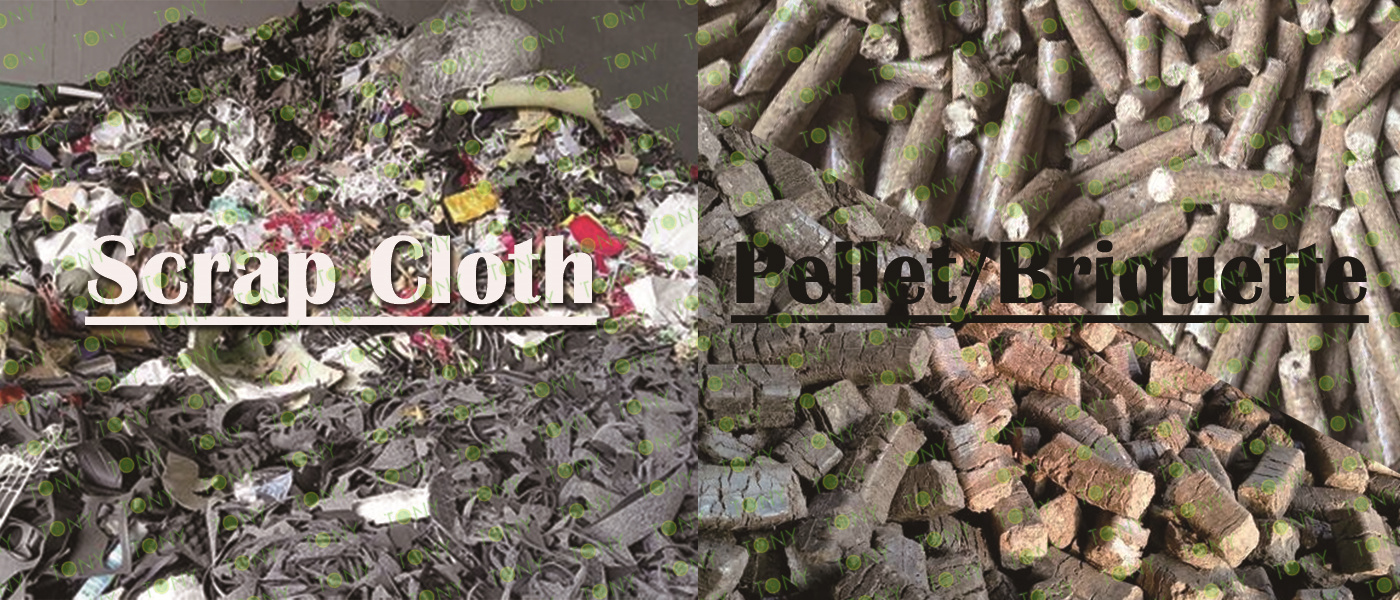


1. Environmental Protection Demand Drives Market Prospects
(1) The Environmental Significance Of Waste Treatment
Scrap cloth, if not properly disposed of, may cause a large amount of solid waste to accumulate and put pressure on the environment. scrap cloth is made into scrap cloth pellet/briquette, which can effectively transform it into a useful resource and reduce the harm to the environment. In the context of increasing global environmental awareness, this environmentally friendly treatment is in line with the concept of sustainable development, and will receive more attention and support, thus providing a broad space for its market prospects.
(2) The Effect Of Emission Reduction Helps Market Development
Scrap cloth pellet/briquette, when burned, can reduce greenhouse gas emissions such as carbon dioxide compared to traditional fossil fuels. For example, in some areas or industries with strict limits on carbon emissions, the use of this renewable biomass fuel can help companies meet emission reduction targets, so its market demand is expected to increase
2. The Positive Impact Of Policy Support On Market Prospects
(1) Policies To Encourage The Development Of Renewable Energy
Many countries and regions are introducing policies to encourage the development of renewable energy. Biomass energy is a kind of renewable energy, scrap cloth pellet/briquette will also benefit from these policies. For example, the government may give subsidies or tax incentives to enterprises that use this biomass fuel, which will stimulate the demand of enterprises and thus promote the development of the market.
(2) Policy Orientation Of Waste Recycling
From a waste reuse perspective, the government also tends to support projects that turn waste such as scrap cloth into useful resources. Relevant policy support may include financial support and convenience of project examination and approval, which are conducive to the development of scrap cloth pellet/briquette industry and provide a strong guarantee for its market prospect.

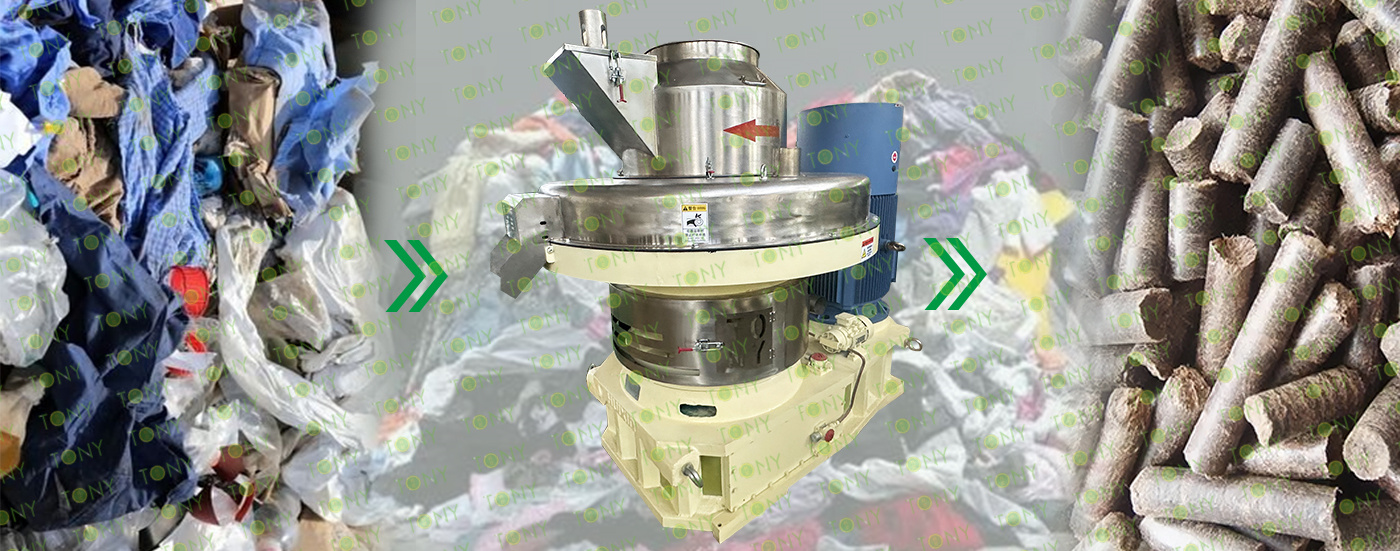
1.The Working Principle Of Scrap Cloth Pellet/Briquette Processing Equipment
Scrap cloth pellet/briquette processing equipment is mainly used to grind the old clothes, old cloth strips, old leather and other raw materials into solid molding material of certain specifications, which is then dried and processed by pellet machine or block press after scrap cloth pellet/briquette processing.Scrap cloth pellet/briquette to make a flammable solid form. It is widely used in power generation, heating and other fields, and realizes the resource utilization of waste not only reduces the pollution of waste to the environment, but also promotes the development of circular economy and improves the utilization rate of resources, which has important environmental protection and economic significance
2.Characteristics Of Scrap Cloth Pellet/Briquette Processing Equipment
(1) Applicability
Scrap cloth pellet/briquette processing equipment can be applied to a variety of materials, such as crop straw, sawdust, shavings, slag, sugar residue, peanut shell, fuelwood, branches, leaves, etc. Scrap cloth pellet/briquette processing equipment can be applied to feed mill, wood processing plant, fuel plant, fertilizer plant, chemical plant and other industries. It is the ideal equipment with small investment and quick effect.
(2) Environmental Protection
Scrap cloth pellet/briquette processing equipment has the characteristics of high efficiency, low energy consumption and environmental protection in the production process, and is widely used in various fields, which is helpful to reduce environmental pollution.
(3) Wide Application Scenarios
Scrap cloth pellet/briquette processing equipment can be used in clothing recycling stations, garbage stations, green energy companies, etc., to promote the sustainable development of new energy.
To sum up, scrap cloth pellet/briquette processing equipment not only has significant economic and environmental advantages, but also has a wide range of applicability and is an important equipment in the future production and environmental protection fields.
3.Application Scenarios Of Scrap Cloth Pellet/Briquette Processing Equipment
(1) Direction Of Waste Disposal
Environmental practitioners are committed to reducing the impact of waste on the environment. scrap cloth pellet/briquette processing equipment can transform scrap cloth into biomass pellet fuel, realize waste reuse, and reduce the environmental problems caused by the accumulation of waste clothes. This is in line with the concept of environmental protection, can be used as an effective means of solid waste treatment, the original difficult to dispose of waste clothes into valuable resources, to a certain extent to solve the problem of waste clothing disposal, promote the development of environmental protection.
(2) Entrepreneurs Seeking New Business Opportunities
Entrepreneurs are always on the lookout for promising new projects. scrap cloth pellet/briquette processing equipment provides such an opportunity that the biomass pellet fuel market is gradually expanding with the increasing focus on renewable energy and waste reuse. The cost of producing biomass pellet fuel by using scrap cloth is relatively low. If stable raw material supply (waste clothing collection channels) and sales channels (such as selling to factories and heating users in need of biomass fuel) can be established, better economic benefits can be obtained, which is an entrepreneurial project with development potential.
(3) Biomass Fuel Producers
For enterprises that have been engaged in the production of biomass fuel, adding scrap cloth as a way to produce raw materials can enrich product types. scrap cloth pellet/briquette processing equipment can help scrap cloth pellet/ Briquette processing equipment be included into the category of raw materials for production, meet the needs of different customers for biomass fuel, and reduce the dependence on a single raw material (such as wood, straw, etc.). Improve the competitiveness and anti-risk ability of enterprises in the biomass fuel market.
(4) Resource Recycling Enterprises
Resource recycling enterprises are mainly engaged in the collection and treatment of various types of recyclable resources. scrap cloth is a part of recyclable resources, and in the past, scrap cloth may simply be sorted and resold for primary treatment. With scrap cloth pellet/briquette processing equipment, they can deeply process scrap cloth and convert it into biomass pellet fuel, thus greatly improving the recycling value of scrap cloth. Increase the profit margin of enterprises, and make resource recycling more in-depth and diversified.
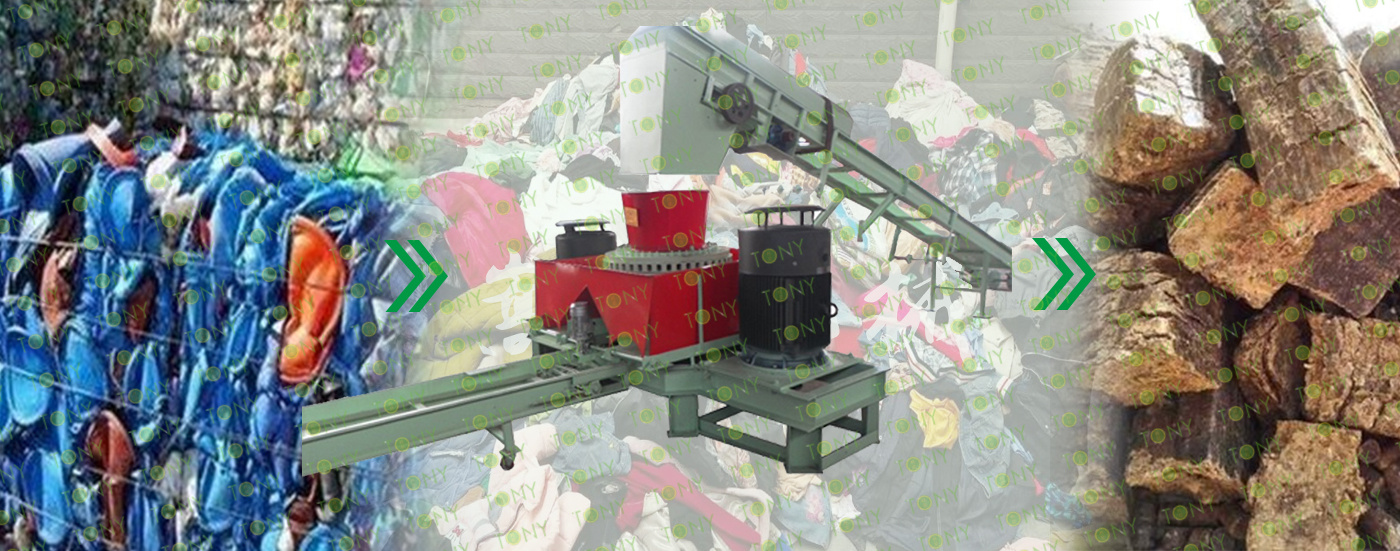

1.Project Name:Scrap Cloth Pellet/Briquette Pellet Line
2.Raw Materisl:Scrap Cloth
3.Moisture Of Raw Material: Dry and wet scrap cloth can be used, wet materials need to use TONY Rotary Dryer to dry scrap cloth,40% of the wet materials are taken as an example.
4.Capacity:TONY can supply customers scrap cloth pelle/briquette line with capacity 0.8t/h-100t/h, according to the actual production needs of customers
5.Process:Tearing Process→Fine Crushing Process→Drying Process→Pelleting Process→Cooling Process→Packing Process
6.Main Machine:Double -axis tearing Machine, Cloth Special Powder Cutting Machine, Rotary Drum Dryer ,Pellet Machine, Briquetting Machine Galvanized Pellets Cooler,Ton Packing Machine And Belt Conveyors
7.Total Power:Based on all selected equipment models,according to all the equipment models selected, different models have different power
8.Need Area: Based on all selected equipment models,according to all the selected equipment models, different models of equipment sizes are different
9.Project Country:Can be used in any country
10.Voltage:The voltage standard of the country in which the equipment is used

TONY brand scrap cloth pellet/briquette production line is a modern production method, which can convert a variety of old clothes, old cloth strips, old leather and other waste materials into efficient and environmentally friendly fuel pellets or briquettes. With the increasing awareness of environmental protection, this production line has gradually become a popular investment project.
1.Capacity: TONY can supply customers scrap cloth pelle/briquette line with capacity 0.8t/h-100t/h, according to the actual production needs of customers
2.Raw materials: Dry and wet scrap cloth can be used, wet materials need to use TONY rotary dryer to dry scrap cloth,40% of the wet materials are taken as an example.
3.Moisture: 40% of the wet materials are taken as an example.
4.Application: Direction of waste disposal entrepreneurs seeking new business opportunities biomass fuel producers resource recycling enterprises
5.Finished Pellets Markets: Large power plants, domestic heating, industrial heating, combustion heat, heating heating, boiler room, school canteen, foundry heat source.

|
Project Brief Introduction: 1. Product: Scrap Cloth Pellet/Briquette Line 2. Capacity:TONY can supply customers scrap cloth pelle/briquette line with capacity 0.8t/h-100t/h, according to the actual production needs of customers. 3. TONY Brand Scrap Cloth Pellet/Briquette Project Process. 4. Main Machine:Double-Axis Tearinging Machine, Cloth Special Powder Cutting Machine, Rotary Drum Dryer ,Pellet Machine,Briquetting Machine,Galvanized Pellets Cooler,Ton Packing Machine And Belt Conveyors. 5. Total Power:Based on all selected equipment models,according to all the equipment models selected, different models have different power. 6. Need Area:Based on all selected equipment models,according to all the selected equipment models, different models of equipment sizes are different. 7. Project Country:Can be used in any country. |
Project Layout For Customer |
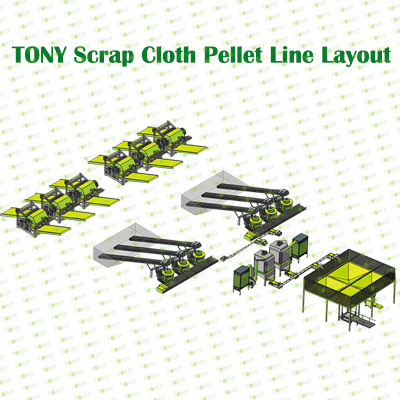 |
|



How to proceed scrap cloth pellet/briquette?
It mainly contains the following steps and machines as following:
1.To Use TONY Double -Axis Tearinging Machine To Tear Wet Scrap Cloth IntoWet Scrap Cloth Pieces .
2.To Use TONY Cloth Special Powder Cutting Machine To Crush Wet Scrap Cloth Pieces Into Wet Smaller Pieces
3.To Use TONY Rotary Drum Dryer To Dry The 40% Wet Smaller Pieces Into 10-15% Dry Smaller Pieces
4.A.To Use TONY Vertical Ring Die Pellet Machine To Products Scrap Cloth Pellet With φ6-8mm.
B.To Use TONY Briquetting Machine To Products Scrap Cloth Briquette With Size 30*30*(30-80)mm
5.To Use TONY Galvanised Cooler Separator To Cool Scrap Cloth Pellet/Briquette.
6.A.To Use TONY Packing Machine To Packing Pellet To 15-50Kg/Bags.
B.To Use TONY Ton Packing Machine To Packing Briquette To 1Ton/Bags
You Can Contact TONY To Get For More Details Information And Quoation.
TONY Can Supply You All The Products As Above With Competitive Price And Excellent Quality.
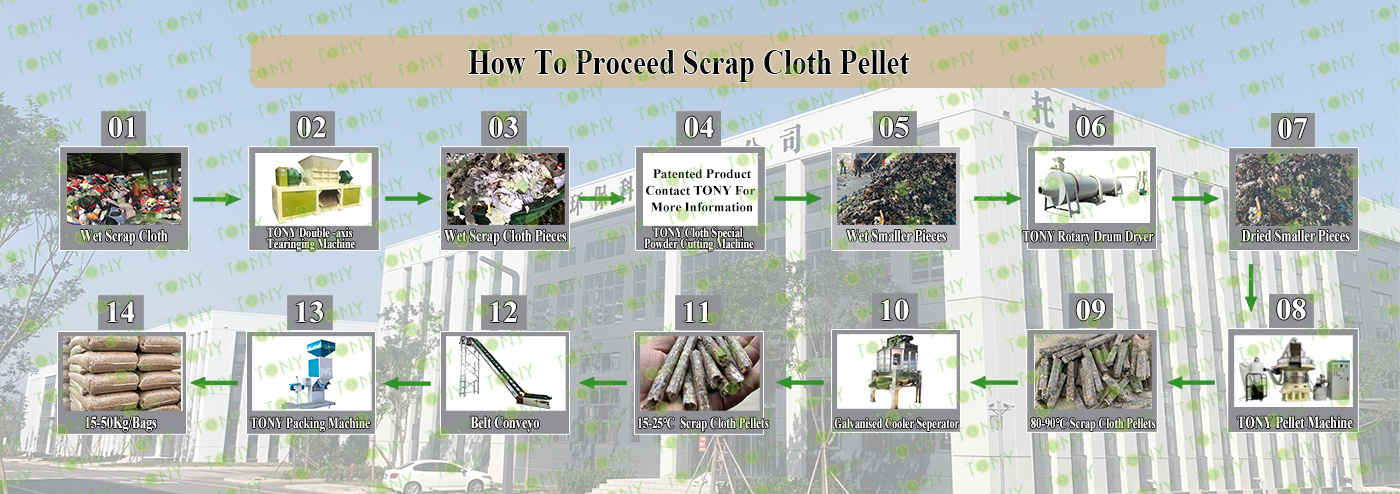
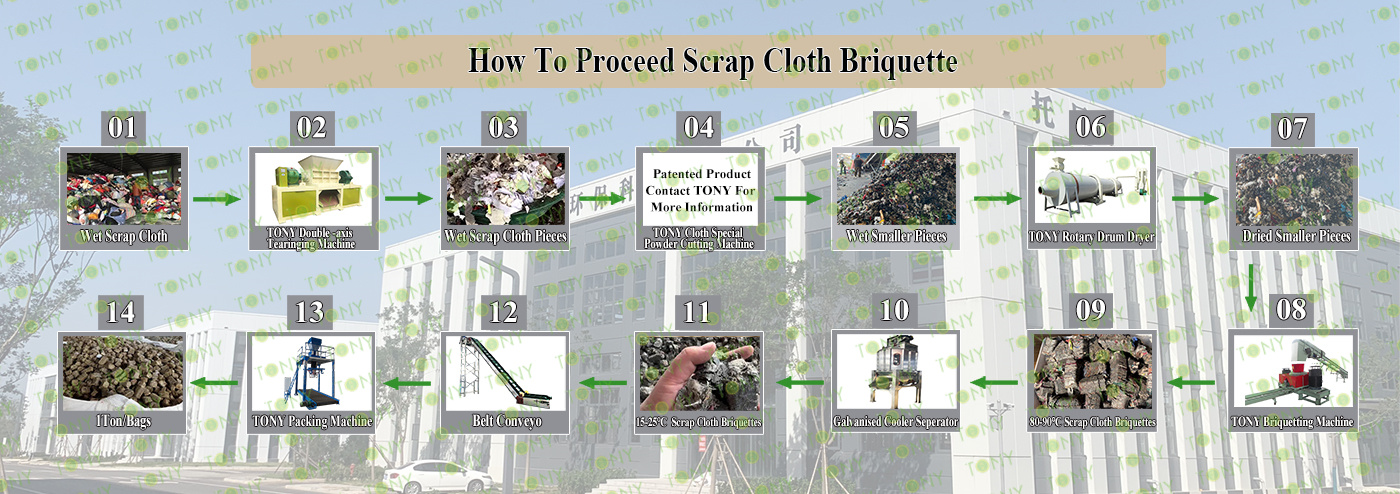


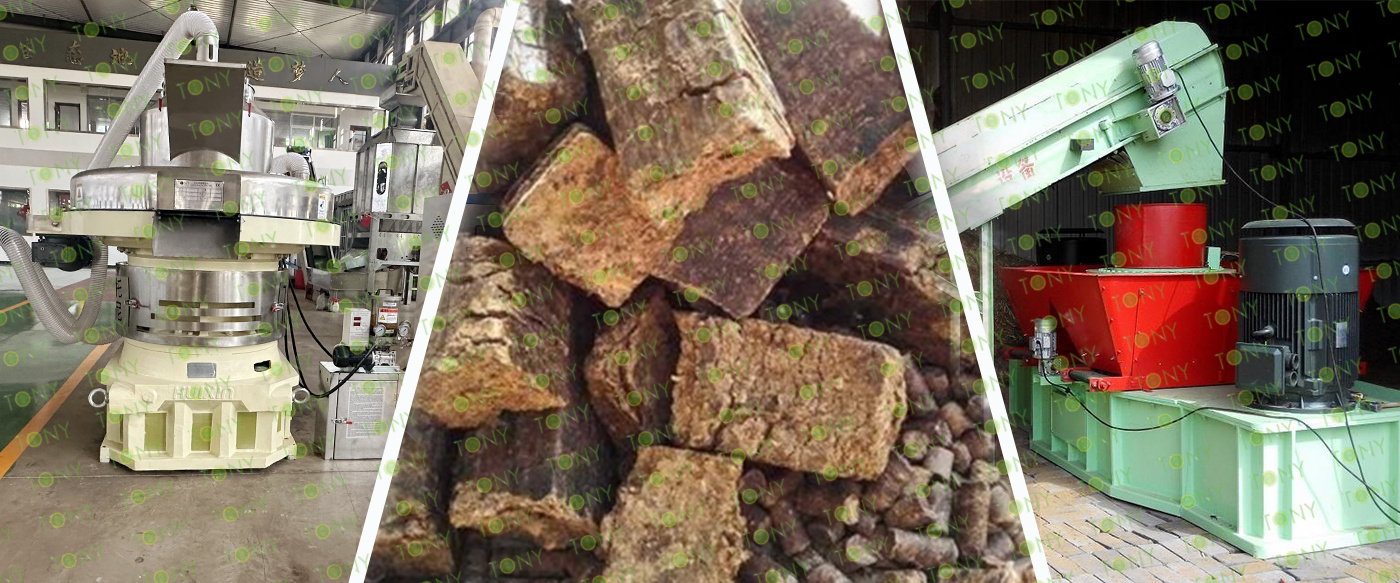
Following TONY Will Introduce For You For All The Necessary Machinery That Will Be Used For The Whole Pellet Production Line. Some machines can be custom made by customer according to different customer's detailed demand.Contact TONY for more details with quotation and layout.
|
|
|
|
|
|
Double-Axis Tearinging Machine |
Rotary Drum Dryer |
Vertical Ring Die Pellet Machine |
Briquetting Machine |
|
1.To Tear The Scrap Cloth Into Scrap Cloth Pieces 2.Models Can Be Selected Or Customized According To Production Needs |
1.To Dry The 40% Smaller Scrap Cloth Pieces Into 10-15% Smaller Scrap Cloth Pieces. 2.Model: Can Be Selected Or Customized According To Production Needs. |
1.To Press The Smaller Scrap Cloth Pieces Into Pellets 2.New 304SS Type 3.Models Can Be Selected Or Customized According To Production Needs. |
1.To Press The Smaller Scrap Cloth Pieces Into Briquetts 2.Models Can Be Selected Or Customized According To Production Needs. |
|
|
|
|
|
|
Galvanised Cooler Separator |
Semi- Auto Packing Machine |
Ton Packing Machine |
Belt Conveyor |
|
1.To Cool Pellets/Briquetts From 80-90℃ to 15-25℃ 2.Model:TLN 3.Capacity:Can Be Selected Or Customized According To Production Needs. |
1.Packing Pellets To 15-50KG/Bags. 2.Model:TBF-50 3.Capacity:Can Be Selected Or Customized According To Production Needs. |
1.Packing Pellets To 1 Ton/Bag. 2.Model:TBD 3.Capacity:Can Be Selected Or Customized According To Production Needs. |
1.Transport Scrap Cloth Pieces,Pellets/Briquetts. 2.Width: Customizable 3.Capacity:Designed With The Whole Line. |


|
1.Scrap Cloth To Scrap Cloth Pieces Process: A. This process mainly to use TONY Double -axis Tearinging Machine to tear scrap cloth into scrap cloth pieces B.Scrap cloth first need to be broken to reduce their volume and facilitate subsequent processing. Main parts: (1) Motor, Reducer Coupling (2) Move The Knife And Set The knife (3) Chassis, Inlet And Outlet (4)Control Cabinet |
|

2.Scrap Cloth Pieces Fine Crushing Process:
A.This process is mainly used to fine crushing scrap cloth pieces into smaller scrap cloth pieces
B.Cloth special powder cutting machine is a kind of equipment specially used for dividing and cutting cloth, non-woven fabrics and other materials. Efficient and precise cutting capability
Main parts:
(1) Crushing Box
(2) Equipment Box
(3) Discharge Plate
(4) Electric Control Cabinet
For patented products, please consult TONY for details and quotes

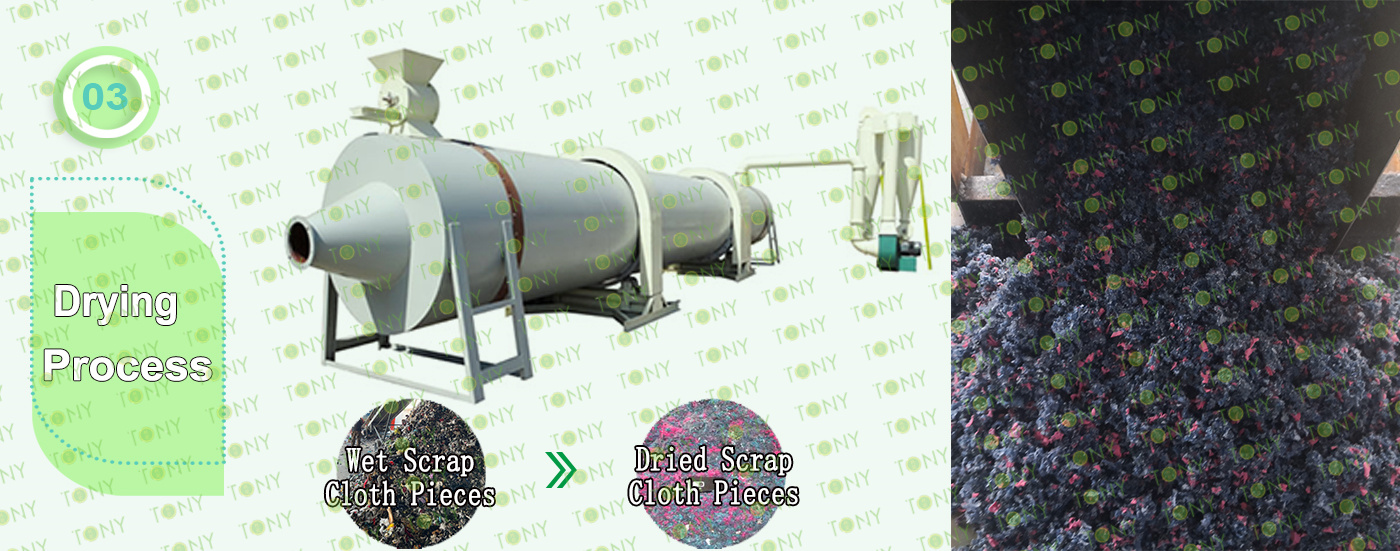
|
3. Wet Smaller Scrap Cloth Pieces Drying Process: A. This process mainly to use TONY Rotary Drum Dryer to dry 40% smaller scrap cloth Pieces into 10-15% smaller scrap cloth Pieces B.TONY dryer use spiral tube material, which has higher heart rate and is not easy to deform. Unlike other manufacturers with iron plate splicing welding, very easy to deformation. C.The operation of TONY dryer requires hot blast stove to provide heat source.Hot blast stove is made of firebrick pan, shell with H steel plate as the frame. There are 3 layers of fire blocking device inside, which can effectively prevent the fire from entering the tumble dryer. A wide range of fuels can be selected, such as coal, straw, firewood and biomass pellets Main parts: (1)TONY's Rotary Drum Dryer Main Body.(Reducers With Motors and Pips.) (2)TONY's Hot Blast Stove. (3)Fan Blower+Cyclone With Airlock. |
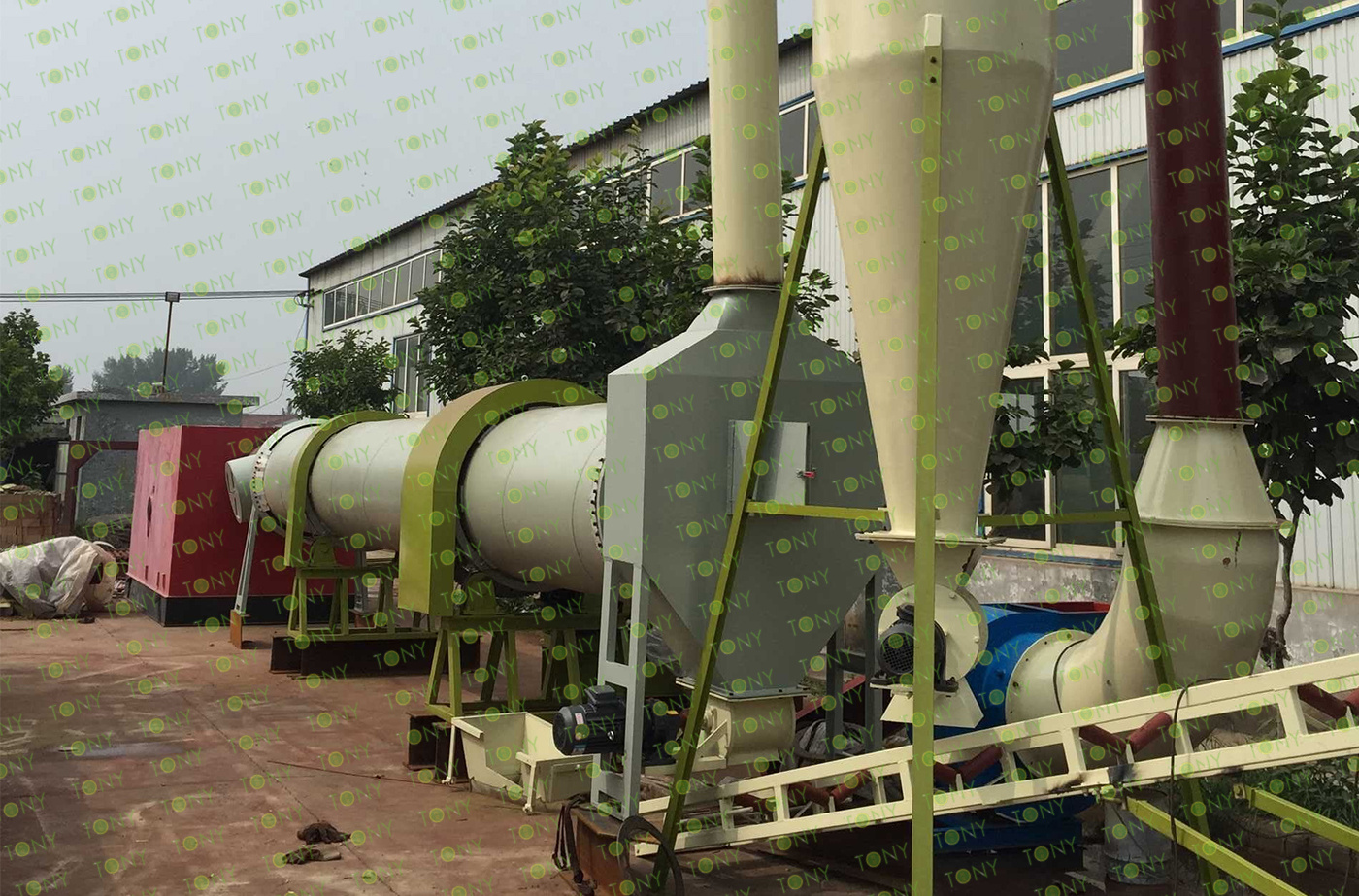

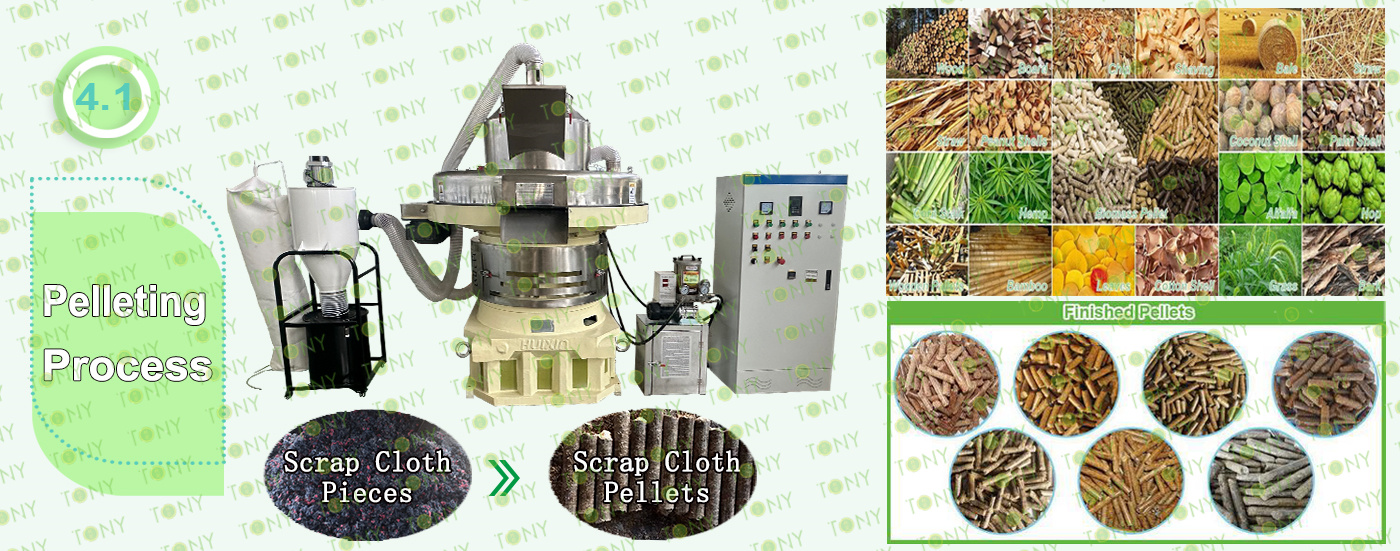
4.1 Pelleting Process:
A.This process is mainly used to product scrap cloth pellets with φ6-8mm.
B.TONY has a variety of models of pellet machine, the output is not the same, you can choose the pellet machine type and the number of pellet machine according to the actual production needs
Main Parts:
(1)TONY's new vertical ring die pellet machine.
(2)Cyclone and bags dust collectors.
(3)Bearings automatic lubrication system.
(4) Electrical cabinets.
You can chose TONY new type SS304 pellet machine or old type MS pellet machine.

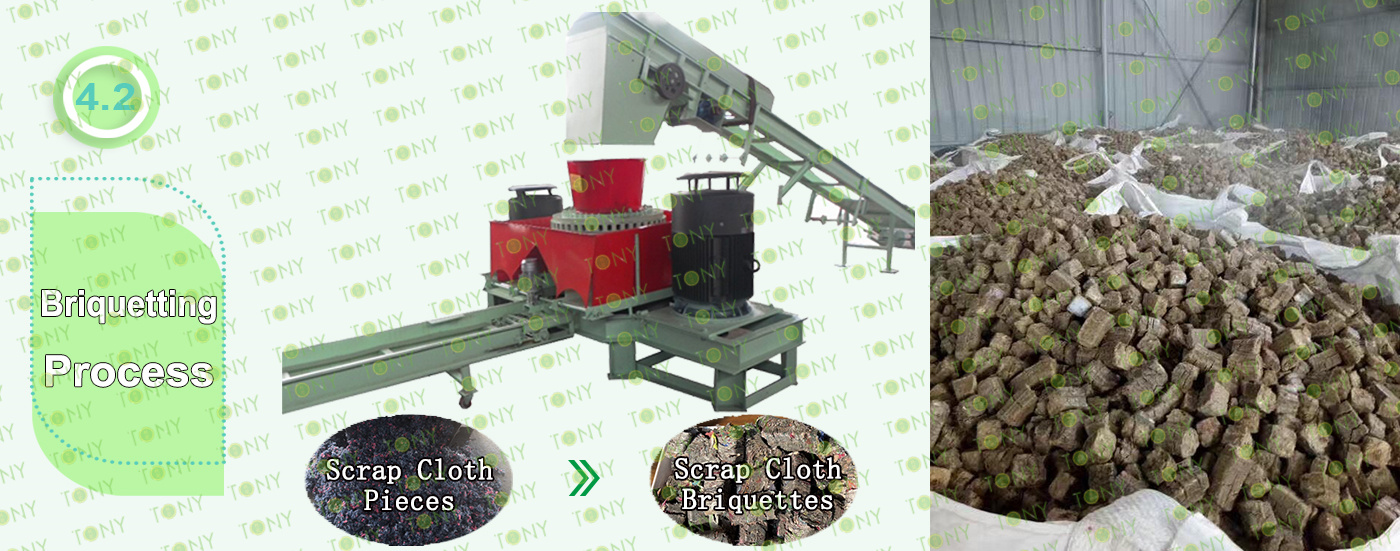
|
4.2 Briquetting Process: A.This process is mainly used to product scrap cloth briquettes with 30*30*(30-80)mm. B.There are a variety of models to meet the needs of different customers. Main Parts: (1) Hydraulic Cylinder (2) Compression Chamber (3) Hopper (4) Feeding Conveyor (5) Hydraulic System And Electrical System |
|

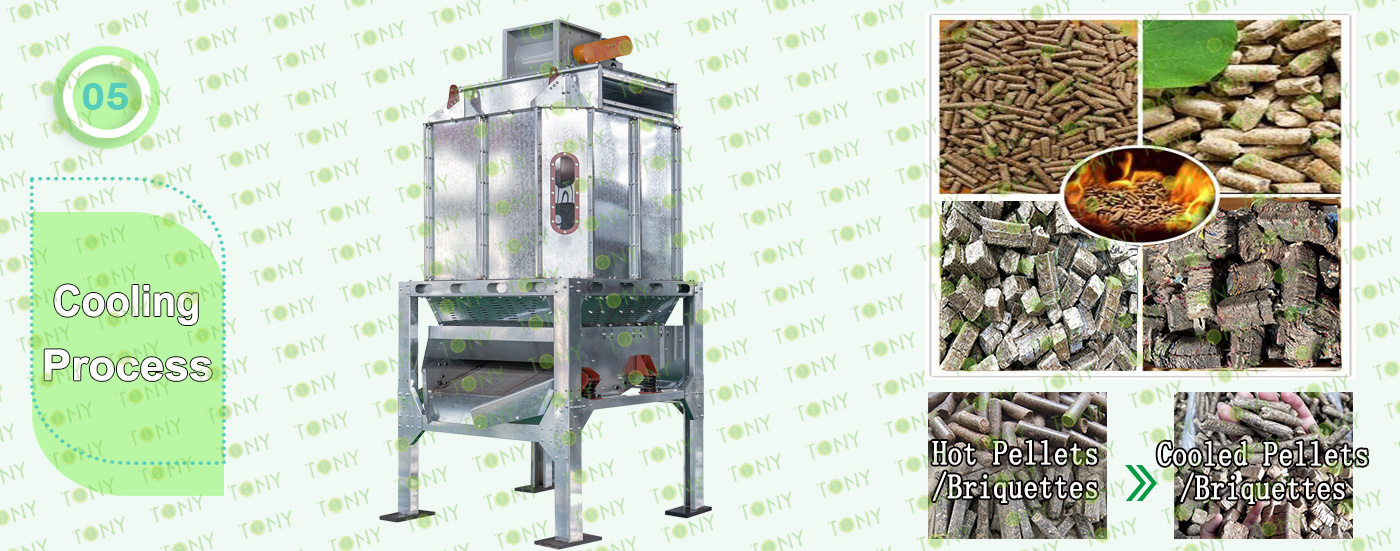
5.Cooling Process:
A.This process is mainly use TONY Galvanised Cooler Separator to cool the scrap cloth pellets/briquettes
B.The TONY Galvanised Cooler Separator model can be selected based on actual production needs
Main Parts:
(1)TONY's new Galvanized Cooler Separator With Vibrating Screen.
(2)Cyclone and bags dust collectors.
(3)Fan Blower.
(4)Connect Pipes.
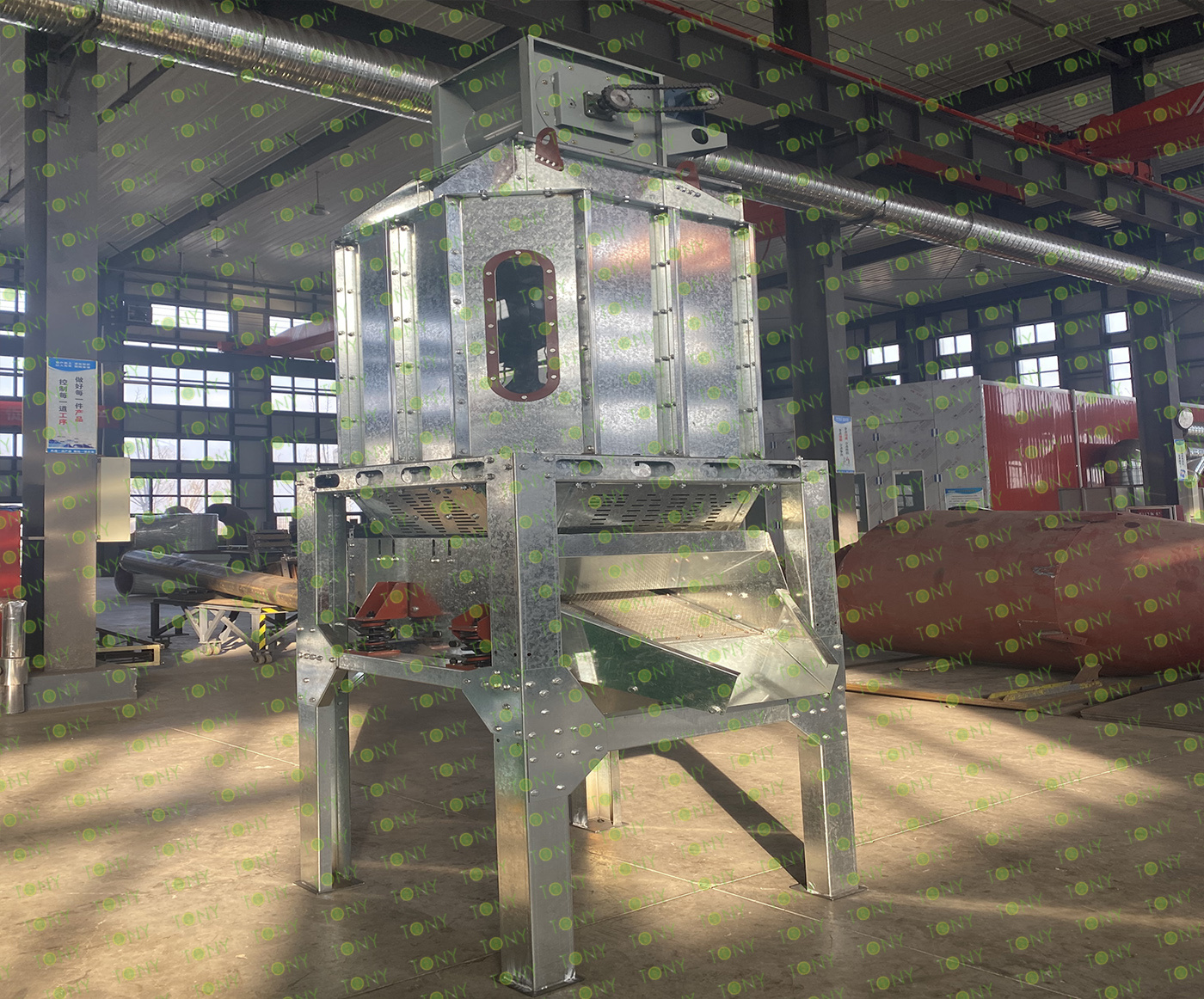

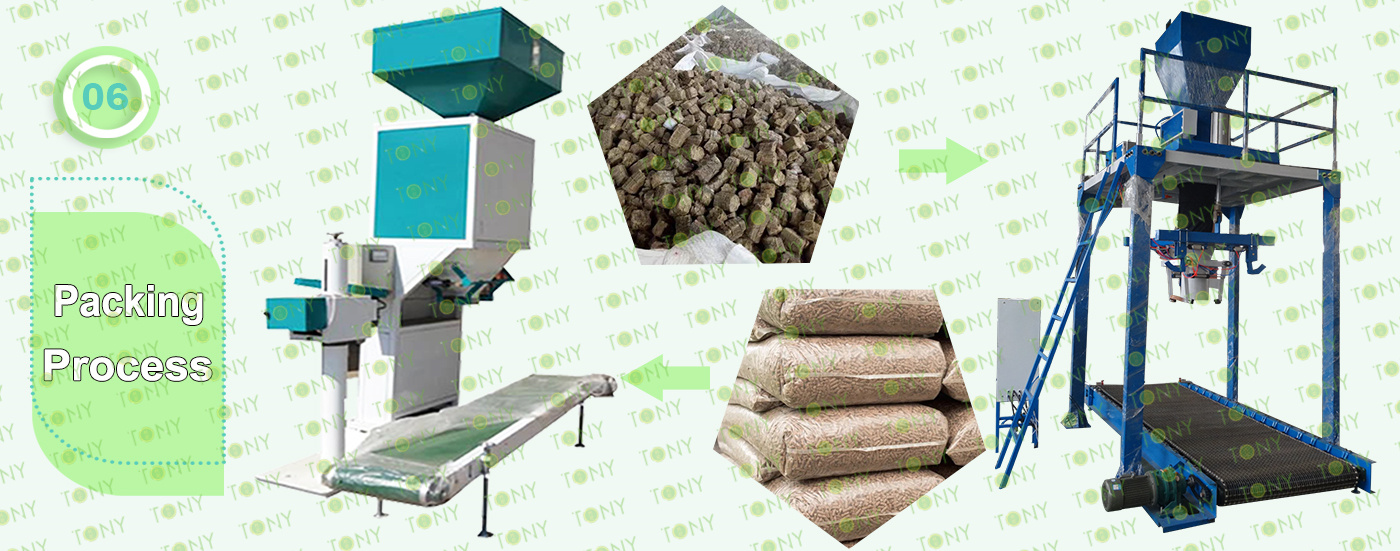
6.Packing Process:
A.This process is mainly used to packing pellets to 15-50kg/bags or packing briquettes to 1ton/bags
Main Parts:
(1)TONY's new TONY Semi-Automatic Packing Machine and Ton packing machine .
(2)Sew Machine,Buyer can also chose Hot Seal Machine for chosen,to confirm with TONY for the price difference.
(3)Bags Transportation Conveyors.
(4)Feeding Inlet Silo
(5)Electrical cabinets.
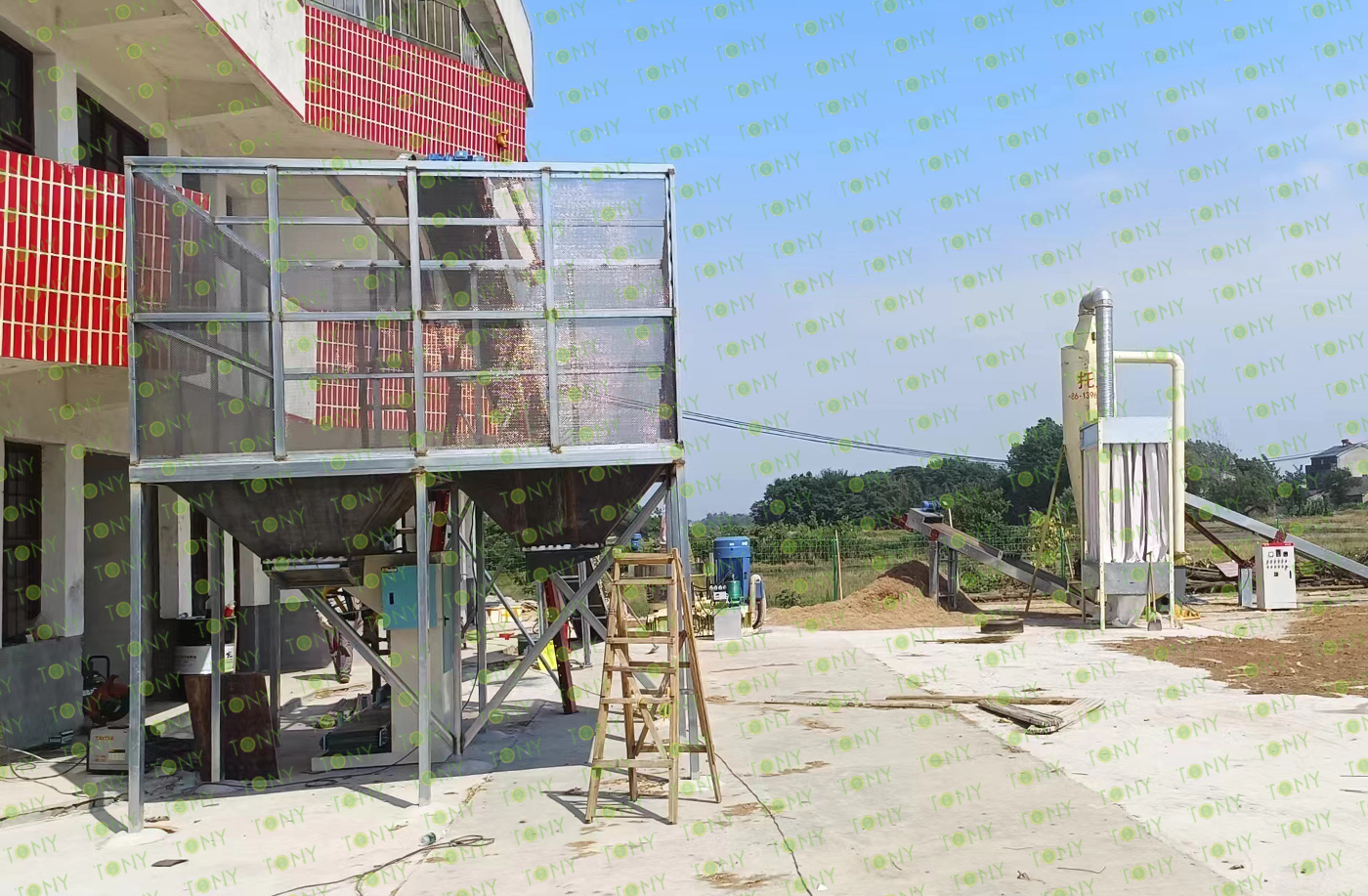

TONY Detailed Design 3D Layout Scrap Cloth Pellet Line According To Cusomer Factor Size
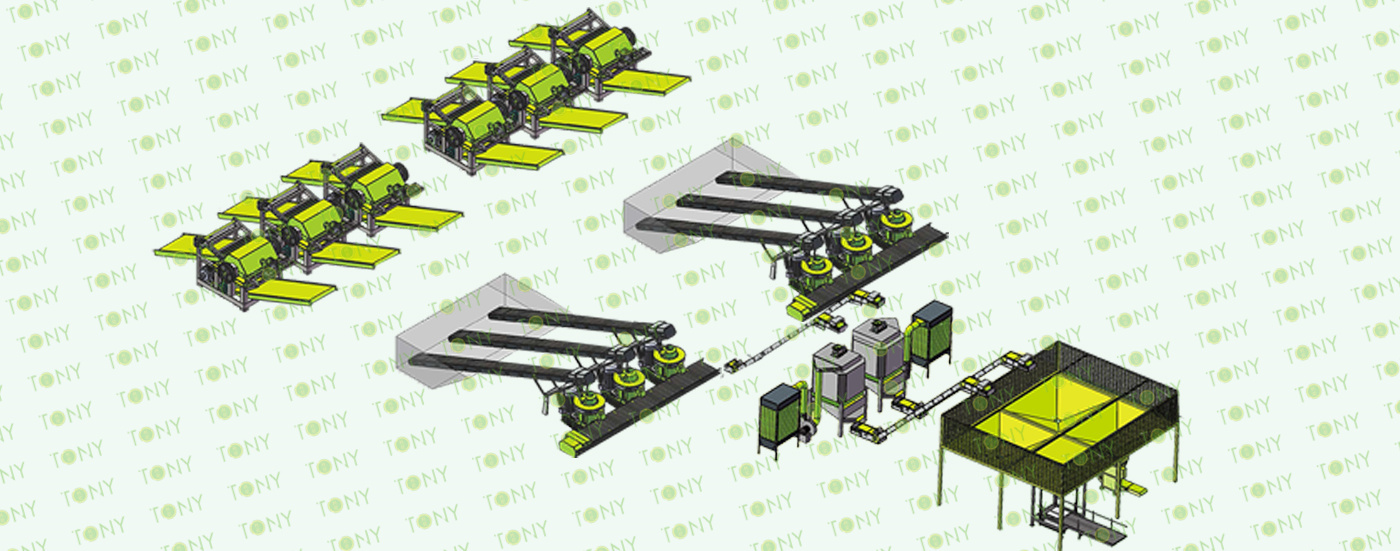

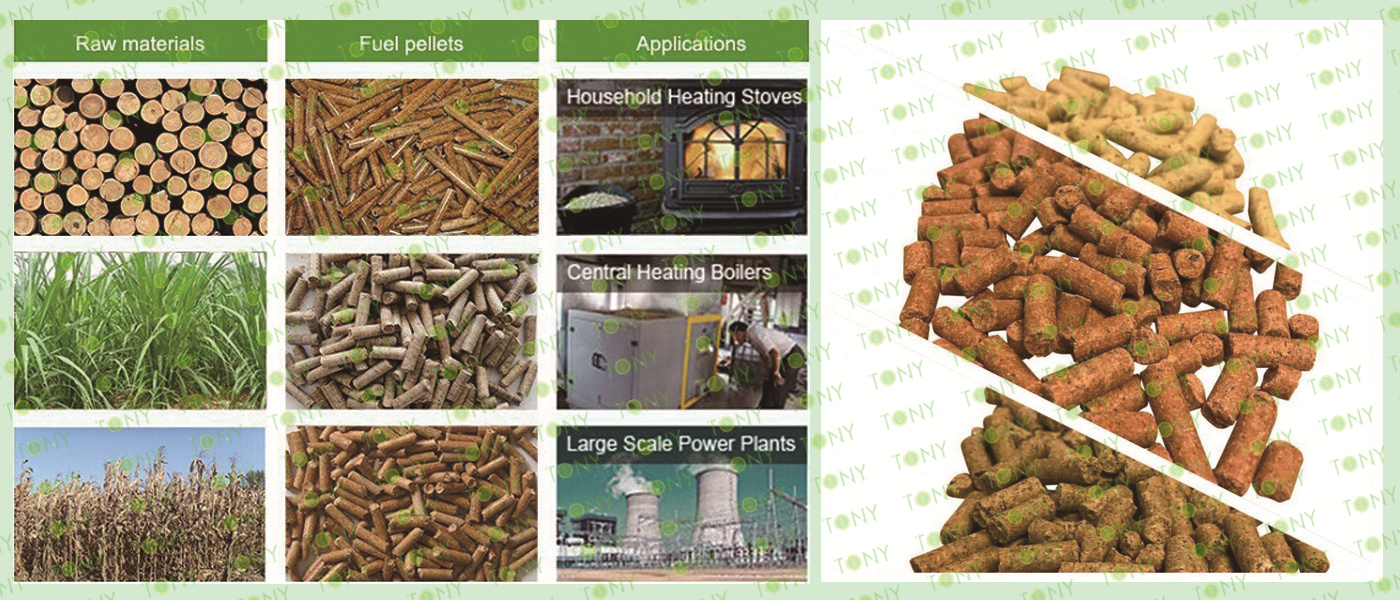
Scrap cloth pellet/briquette have many advantages, which are mainly reflected in the following aspects:
1. Environmental Protection
(1) Reduce The Amount Of Landfill
Every year, a large amount of scrap cloth is discarded around the world, and if scrap cloth is made into pellets, the amount of clothing sent to landfills can be greatly reduced. If the scrap cloth is not recycled and buried directly, it will occupy a lot of land resources, but the scrap cloth made into pellets can effectively avoid this problem.
(2) Reduce Incineration Pollution
The incineration of scrap cloth will produce toxic gas harmful to human health, and the residue after incineration will also cause irreversible damage to the soil. By making scrap cloth into pellets for reuse, the environmental pollution caused by incineration can be reduced.
(3) Reduce Carbon Emissions
The clothing industry accounts for 10% of the world's annual carbon emissions. 72% of scrap cloth is made of polyester fiber. The material containing plastic is difficult to biodegrade by nature, and it may take at least 200 years to decompose. Recycling scrap cloth into pellets can effectively reduce carbon emission.
2. Resource Utilization
(1) Improve The Utilization Rate Of Used Clothing Resources
After recycling the scrap cloth, by processing it into pellets, the residual value of the old clothes that might otherwise be left idle and wasted can be utilized as much as possible. At present, the disposal channels of scrap cloth are relatively simple, and making scrap cloth into pellets is an effective way to improve the utilization rate of scrap cloth.

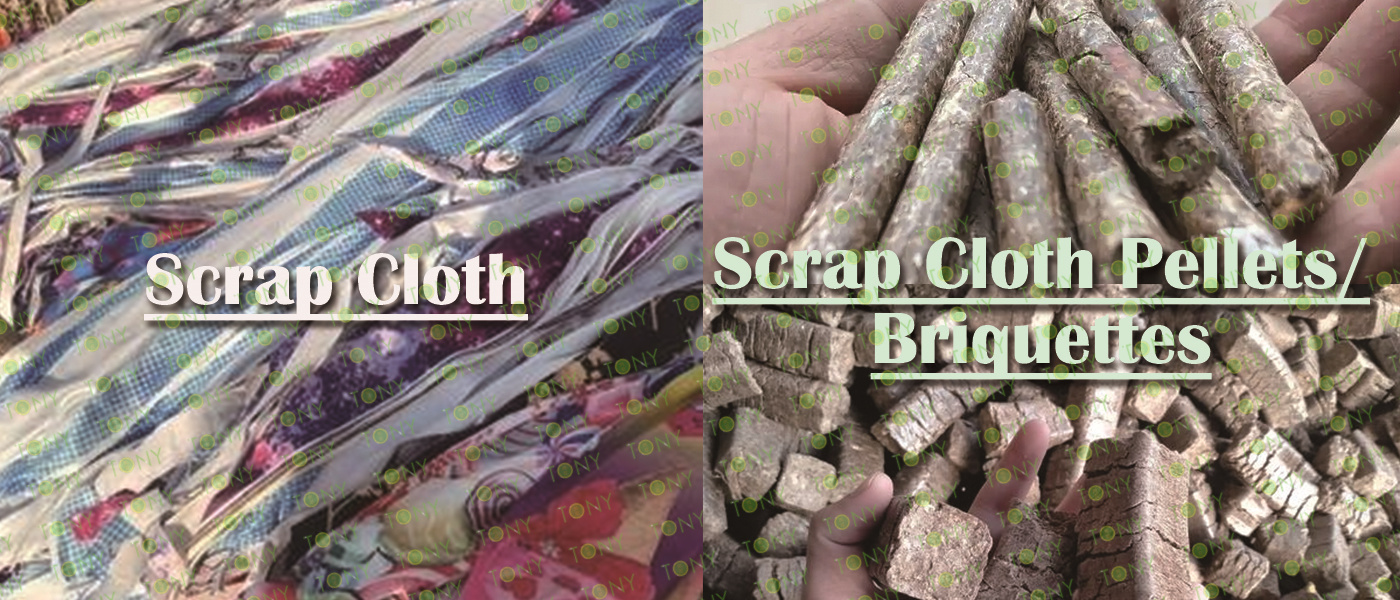
Scrap Cloth Pellet/Briquette, As A New Type Of Biomass Fuel, Has Many Advantages:
1. Clean And Environmentally Friendly
Scrap cloth pellet/briquette is a kind of natural biomass pellet fuel, which can replace city gas. Scrap Cloth pellet/ Briquette has low moisture content, easy adjustment of combusing-supporting air and high combustion thermal efficiency. It can reduce greenhouse gas CO2 emissions, low SO2 emissions, and dust emission standards, helping to reduce NOx generation.
2. Save Space
Because the biomass fuel is compressed at high temperature, it greatly saves storage space and is easy to transport. This characteristic gives scrap cloth pellet/briquette a significant advantage in storage and transportation.
3. High Combustion Thermal Efficiency
Scrap cloth pellet/briquette can greatly improve the combustion performance of wood materials, and the thermal efficiency can be increased by more than 80%. The heat generated by 1 ton of biomass pellet fuel is equivalent to 0.8 tons of coal, showing its efficient energy conversion ability.
4. Safe Use
Scrap cloth pellet/briquette is obtained from biological fertilizer or wood bran in natural state and does not contain fissionable, explosive and other chemical substances. Therefore, accidents such as poisoning, explosion and leakage will not occur. This makes the waste cloth pellet fuel safer and more reliable during use.
5. Sustainable Use
Scrap cloth pellet/briquette ash after combustion can be used as fertilizer to promote the growth of new plants, enter a new cycle, and make the supply of biological resources continuous and sustainable use. This characteristic reflects the sustainability and environmental value of waste cloth pellet fuel.
6. Economic Benefits
The use of waste cloth pellet fuel can significantly reduce operating costs, which can save 40%-50% of operating costs than oil, gas, and electric heating. In addition, farmers can earn additional income by selling combustible waste such as waste cloth, which helps improve rural living environment and increase villagers' income

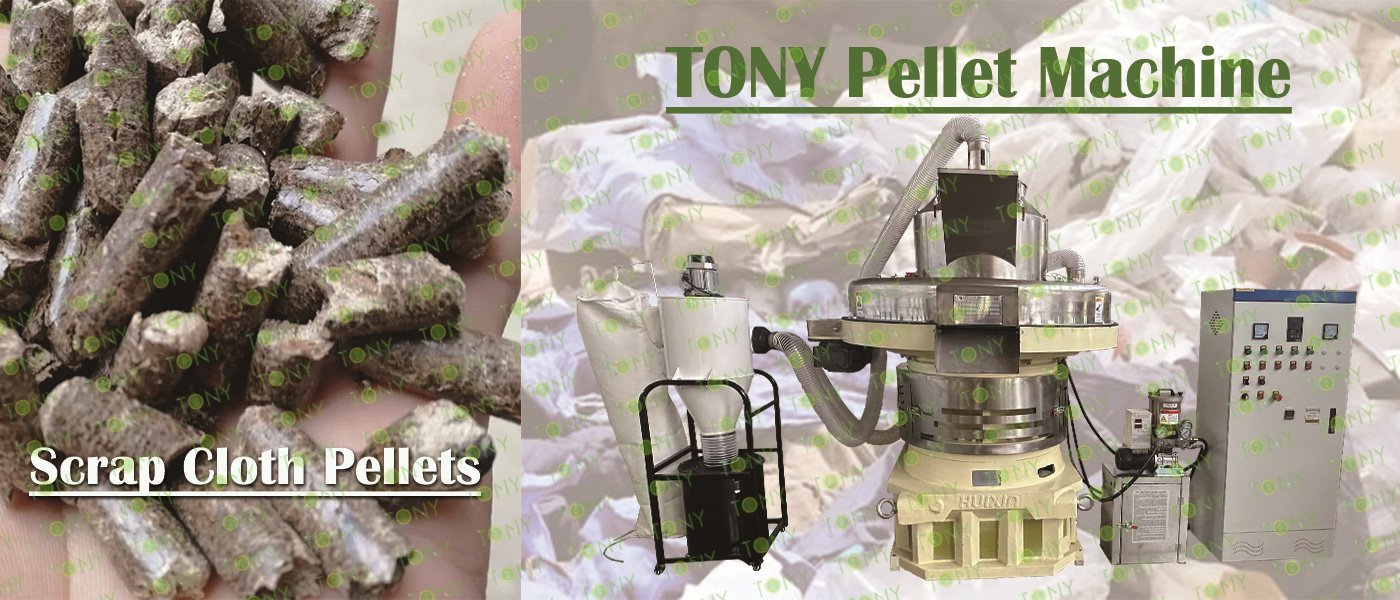

1. Project Background
There are many problems in the traditional disposal of scrap cloth, such as the limited amount of donations, the uneven quality of remanufactured clothes, and the difficulty in dealing with mixed fibers in textile recycling. However, making scrap cloth into fuel provides a new way for the recycling of scrap cloth.
2. Project Advantages
(1) Environmental Benefits
Reduce landfill pressure: Scrap cloth, if not properly used, will often be landfill, occupying a lot of landfill space. Making it into scrap cloth pellet/briquette fuel can greatly reduce the load on landfills and avoid environmental problems such as soil pollution that may be caused by landfills.
Reduce greenhouse gas emissions: Compared with traditional fossil fuels, pellet/briquette fuel made from scrap cloth can reduce greenhouse gas emissions during combustion. When used in power plants, cement plants or other energy facilities, this pellet fuel helps reduce carbon emissions throughout the energy production process, in line with global needs to combat climate change.
(2) Economic Benefits
Turn scrap cloth into treasure: Scrap cloth is originally waste and has little economic value. By making pellet/briquette fuel, it can be transformed into an exploitable resource, bringing a new source of economic income to the business. For example, some companies sell the pellet/briquette fuel they produce to energy companies that need it, increasing the value of waste items.
Cost savings: In the process of disposing of waste clothes, the cost that would otherwise be spent on the disposal, storage and transportation of waste clothes can be saved after the pellet/briquette fuel is made. At the same time, compared with traditional fuel, scrap cloth pellet/briquette may have cost advantages in some cases, such as in some small enterprises or specific industrial production links that are more sensitive to fuel cost.
3. Application Prospect
The resulting scrap cloth pellet/briquette fuel can be used in power plants to replace some traditional fossil fuels and provide energy support for electricity production. It is helpful to reduce the dependence on traditional energy in the production process and achieve the goal of energy conservation and emission reduction. In addition, it can also be applied to other energy facilities, such as some industrial boilers, etc., to provide heat energy for industrial production. With the continuous development and improvement of technology, scrap cloth pellet/briquette is expected to be applied in a wider range, which has a positive role in promoting the realization of the country's dual-carbon goal

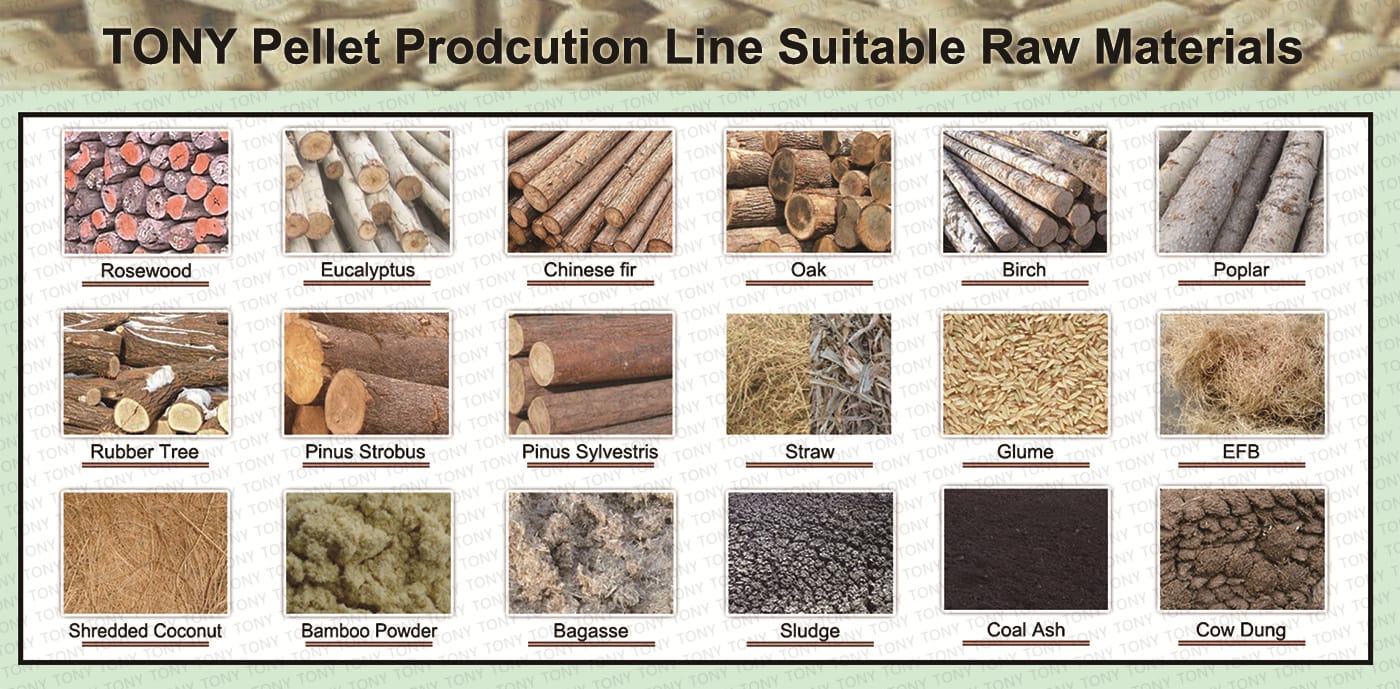
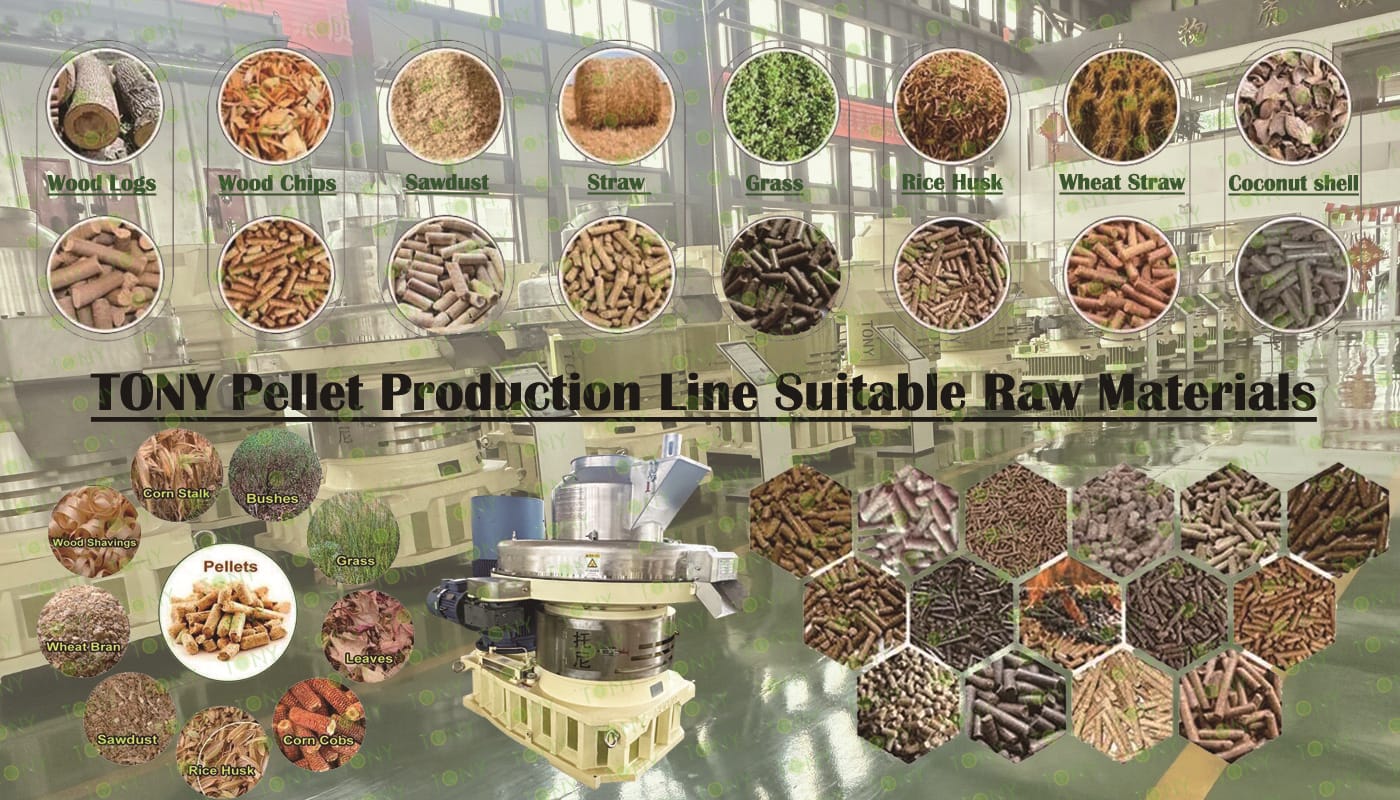

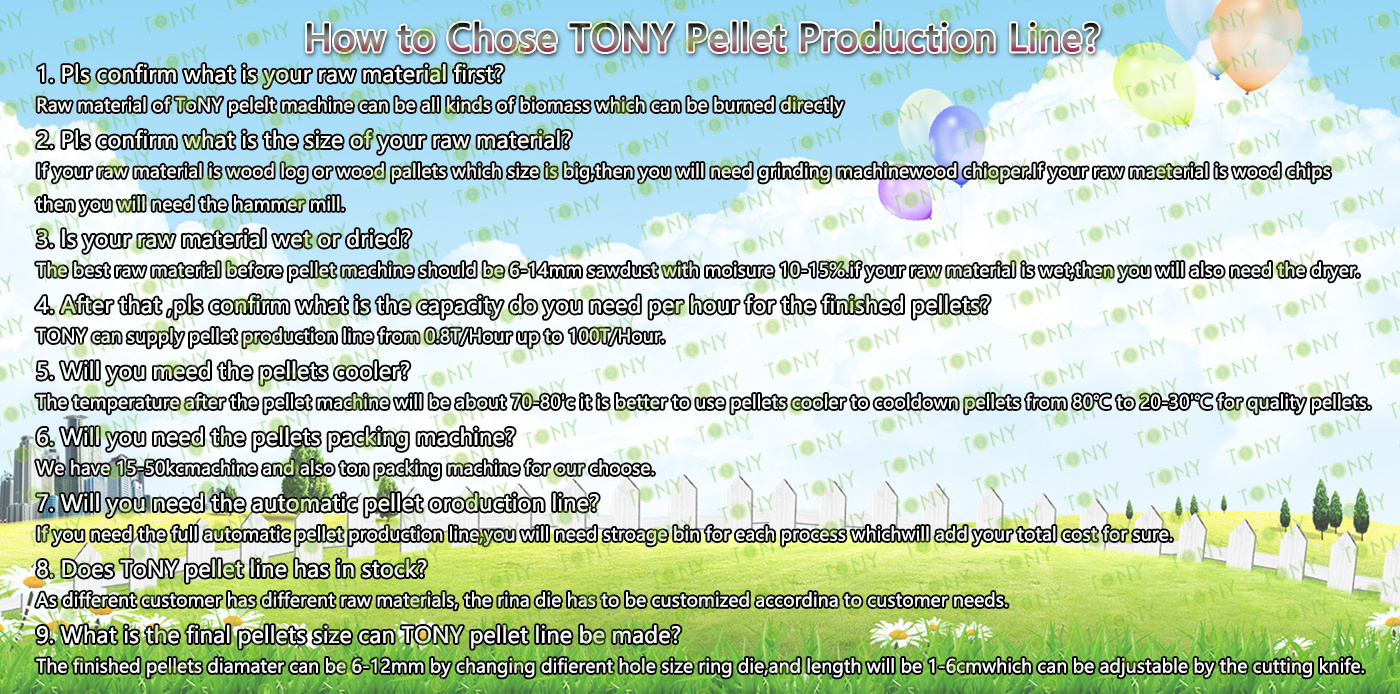

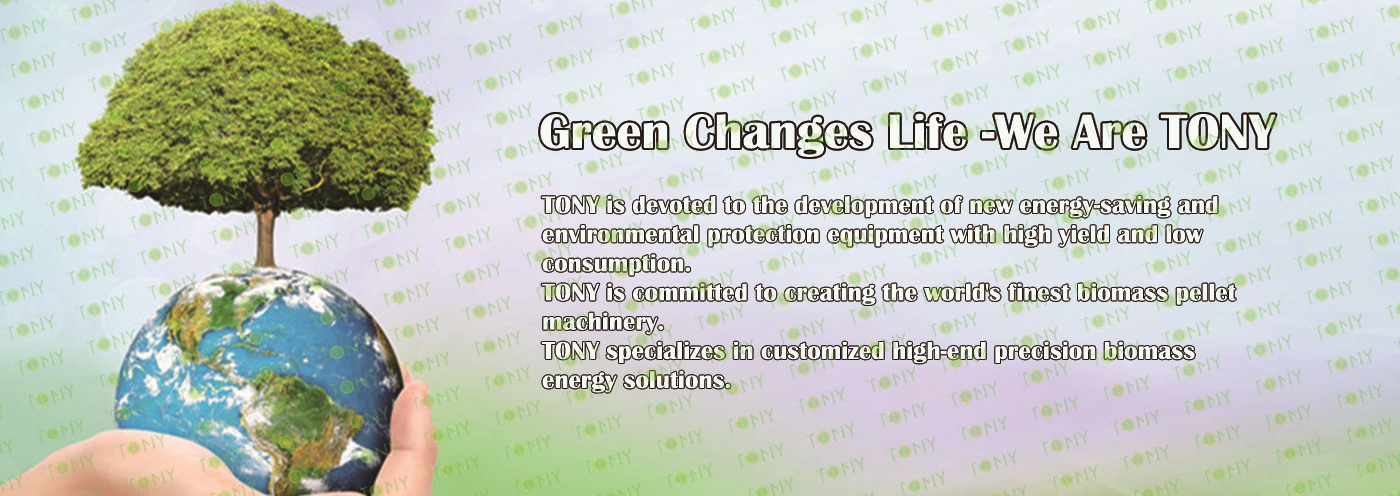
2025 Tony Machinery - All Rights Reserved. Map